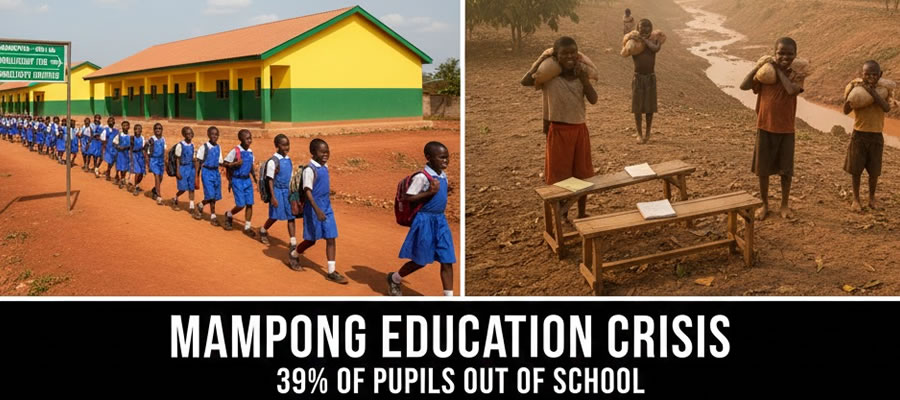

Population
The Municipal has a projected population size of 107,331 for 2021 males being 49.8% whiles the female population represents 50.2% (Source: Ghana Statistical Service –Population Estimates for Ashanti Region-2017). The population has been increasing over the years with a growth rate of 1.8%. Population density is defined as the number of people per square kilometer (km2 ) of unit area of land.
The population density in the Municipality 27.0 persons per square kilometer (22 persons/km2 ), which is less than the regional population density of 45.9 persons per square kilometer and the national figure of 49.3 persons/km2 . This low density of the Municipal implies that there is low concentration of people in the Municipal and coupled with scattered nature of settlements make it extremely difficult to provide basic services to the people of the district. It also makes monitoring and evaluation of programmes and projects difficult to undertake. The population of the municipality was 88,051 (Ghana Population and Housing Census 2010), as against 102, 288in 2018 (MPCU projection, 2018).
The population has been increasing over the years with a growth rate of 1.8%. The population is expected to increase from 102,288 to 107,331 up to the end of the planned period of 2021 as in table…...The Municipality has a sex ratio of 94. The population depicts a broad base population pyramid which tapers off with a smaller number of elderly persons.
Out of the total working population of 33,001, 50.0 percent representing 17, 867 were found in the agriculture sector with 58.1 being male and female representing 50.5 percent.17 percent of the working population who are in agriculture are within the age brackets of between the ages of 35 to 60+ years. Is implication on food security in the Municipality cannot be underestimated. Agriculture policy aimed at attracting the young ones into the sector should be promoted. That is why the planting for food and jobs and planting for export policies should be rolled - out in the Municipality to cater increasing population.
Spatial Distribution of Population
The population of the Mampong municipality is fairly distributed. However, the bigger towns have relatively large populations as compared to the smaller towns/communities. Sample of Sixteen (16) communities and their projected populations (2021 – 2024) is shown in the table below.
From the table above it can be observed that about 84% of the population is concentrated in the Sixteen (16) top communities. This shows that urbanization is catching up in the municipal area.
Whilst the relatively bigger towns continue to experience increase in population as a result of immigration from smaller towns within the municipality and increased birth rate, the rural community experience low population due to migration. The urban settlements are Bosofour, Daaho, Kyeremfaso, Kofiase and Mampong. In all the urban population represents 55.5% of the total population whilst the rural population represents 44.5% With a constant increase in population growth, the municipality would again experience an increase in population densities during the plan period. The table below shows the projected population densities for the plan period.
Household Sizes/Characteristics
The municipality currently has an average household size of 4.6 persons per household made up of 4.2 for Urban and 4.9 in the rural areas. This phenomenon is higher than the national figure of 4.4 persons per household. The situation is attributed to the fact that, the municipality over the years experienced high fertility and low mortality rates due to quality health care and improved living standards.
It also has age dependency ratio of 84.1 which is above the national and regional figures of 77.2 and 80.9 respectively. There is therefore an imperative need to provide more employment opportunities as well as income generating activities to absorb the majority unemployed population as this will go a long way to curtail the problem of dependency within the municipality.
Settlement Systems
Rural - Urban Split
The municipality is largely rural constituting about 54.7 percent of the entire population. It is made up of seventy-nine (79) settlements of which Mampong, Kofiase, Nkwanta, Benim, Yonso, are the major urban towns, having population of more than 5,000. About 55% of the municipal’s population live in these two towns while about 10% live in the only semi-urban town of Asaam and Mprim.
It is therefore imperative to emphasis on rural development while at the same time providing needed Infrastructural facilities for the few urban settlements to perform their roles as service centers. The ten largest communities arranged in order of population sizes are Mampong, Kofiase, Asaam, Benim, Atonsuagya, Yonso, Adidwan, Ninting, Daaho and Abuontem. This stage of analysis deals with the organization of human and economic activities in space within the Mampong Municipality. This stage of Development planning is concerned with the social and economic functions that settlements perform and how in combination they influence economic and social development within the municipal area.
The approach uses a combination of methods to determine the spatial pattern or system of the municipal development. Those considered important for analysis of the Mampong municipal’s Spatial Organization are:
a. Scalogram Analysis
b. Surface Accessibility Analysis Scalogram Analysis The scalogram is a graphic device that illustrates in the form of a matrix chart the distribution of functions of all selected settlements in a locality by their frequency of presence or absence.
The scalogram gives a good impression about the functions that settlements perform in a particular locality. This in a way assists in the determination of which settlements lack which services or facilities.
It is also useful in categorizing settlements in the Municipality into levels of functional complexity. The complexity serves as the means to the determination, in the future of types and diversity of services of the municipal area at various levels in the hierarchy. In effect scalogram can be used to make decision about appropriate ‘Package’ of investments for settlements in the Municipality at different levels in the spatial hierarchy.
In constructing the Municipal scalogram, a total of 26 functions were considered on presence or absence basis for all selected settlements. The settlements included in the analysis were selected using a population of 1400 as the cut-off point. Since the scalogram does not give any indication of quantitative and qualitative features or services and facilities, a weighting technique based on the frequency of occurrence of service/facilities was applied.
The weights were added to determine the total centrality from highest to lowest hierarchy. The resultant diagram is shown in the figure below. Therefore, the centrality index for a settlement is the sum of the weights of functions found there. The higher the index, the greater it’s functional complete.
Settlement Hierarchy and Scalogram Analysis
A Scalogram (Functional Matrix) and a hierarchy of settlements map representing the municipality is drawn on the level of facilities, services and population size on the 30 big towns. Services are grouped under Education, Security, Commerce, Agriculture/Forestry, Health, Water, Sanitation etc. Mampong, the municipal capital enjoys most facilities as compared to other towns. It is the most densely populated settlement within the municipality and the only town with a population of over 10,000 inhabitants. It has facilities and services like tertiary education, hospital, pipe borne water, electricity, high court, telephone services, and financial institutions, among others. There is no 2nd level settlement because there is a big disparity between Mampong and the other towns in terms of population size and level of services.
The 3rd level settlement is Kofiase. This community has population of 6,334 with facilities and services such as health, education, financial, water and sanitation etc. The 4th level of settlements has population between 2,000 and 4,000. They are Adidwan, Benim, and Asaam. The last group of Settlements, which form the majority, includes Apaah, Kyekyewere, Yonso, Old Daamang, New Daamang, Oseikrom, Nnaama, Anyankamamu, Woraso, Sekruwa, Kofi Sarpong etc.
They have population of less than 2,000 inhabitants. The large disparity in population between Mampong and other settlements within the municipality is attributed to the fact that Mampong has higher services and facilities. There is therefore the need to provide basic facilities and services such as good housing, potable water and sanitation, good roads, telecommunication systems, drainage systems, health, education, as well as electricity in the less endowed communities to improve living conditions.
Figure 5: Hierarchy of settlement Map
Source: Mampong Municipal Assembly, Physical Planning, 2021
Date Created : 11/25/2025 7:51:55 AM












 facebook
facebook
 twitter
twitter
 Youtube
Youtube
 +233 593 831 280
+233 593 831 280 0800 430 430
0800 430 430 GPS: GE-231-4383
GPS: GE-231-4383 info@ghanadistricts.com
info@ghanadistricts.com Box GP1044, Accra, Ghana
Box GP1044, Accra, Ghana